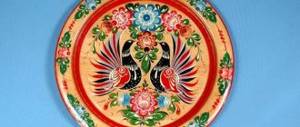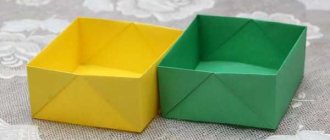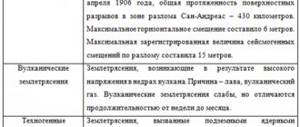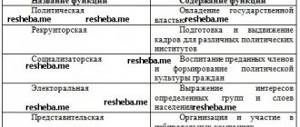Lesson plan for 5th grade, on the topic “Gorodets painting”
Irina Buslaeva
Lesson plan for 5th grade, on the topic “Gorodets painting”
Topic: “Gorodets painting”
Lesson objectives:
Educational: introduce students to a new type of painting - Gorodets painting, as well as introduce them to the history of Gorodets painting, talk about the features of this painting.
Developing: creative activity, taste, imagination, attention.
Educational: to cultivate love and interest in the native culture.
Materials : illustrations depicting Gorodets painting, paper, paints, brushes.
Equipment: board, chalk.
Visual aids: works painted with Gorodets painting: L. Bespalova Small chest-bench, F. Kasatova Cutting board, Gorodets box of the 20th century, images of painting of kupok and roses, L. Bespalova Panel “Flowers” 1980s.
Time: 40 minutes.
No. Lesson progress Method, time
1. Organizational moment: greeting, checking students’ readiness for the lesson 1 min; conversation.
2. Statement of the topic and purpose of the lesson:
The topic of today's lesson: “The Art of Gzhel”
2 minutes; story.
3. Explaining new material, consolidating new knowledge:
In this lesson we will talk about Gorodets painting - a Russian folk art craft that has existed since the mid-19th century. It originated in the city of Gorodets, not far from Nizhny Novgorod.
The procedure for performing Gorodets painting: 1) on a wooden base, primed with yellow, red and black colors. 2) The main spots are outlined - flowers, which represent the composition. 3) thin strokes of a darker tone of the same shade are applied to large spots. Then the leaves - 2-3 strokes. 4) using a thin brush, apply strokes and dots with black or white paint.
Composition:
1) Flower painting
Bouquet - the arrangement is symmetrical;
Garland - 1-2 large flowers, and smaller ones in different directions;
Diamond - 1-2 flowers form the center, and buds and small flowers are located further away.
2) Floral arrangement including “horse” and “bird” motifs
3) Story painting 10 min; explanations, demonstration.
5. Introductory briefing and trial work:
A) message about the name of the practical work - and today we will paint a cutting board with Gorodets painting.
B) stages of work:
1. We arrange a board on the entire album sheet;
2. Prime it with yellow, red or black.
3. We apply the main motifs of Gorodets painting. We create a composition with bright spots and complement it with leaves in one stroke. 4 min; explanations, demonstration.
6. Practical work:
Detour #1. Checking the organization of students' workplaces. (desktop, brushes, watercolors, album).
Detour No. 2.
Mistakes that students may make:
• The board is finely laid out on a landscape sheet;
• The color or shade for the painting is not chosen correctly.
• Incorrect placement of key elements.
Bypass No. 3.
• Providing assistance to students who are poorly prepared to complete the task.
• Rational use of student's educational time. 20 minutes; explanation;
practical and independent work.
7. Conducting work results (final briefing):
• Analysis of students' independent work;
• Analysis of common mistakes;
• Objective assessment of the results of individual work. 2 minutes; demonstration, display.
8. Cleaning workplaces. 1 min.
Technological map of the Fine Arts lesson 5th grade Gorodets painting
Let's imagine that we are at the Gorodets fair.Every week, on Saturdays, here. Peasants from surrounding villages came to Gorodets, merchants came from different cities, including Nizhny Novgorod. And no matter how varied the goods on display were, they could not outshine the products of local craftsmen - artistically designed toys, spinning wheels, wooden utensils from Khlebaikha, Kurtsev, Koskov and other villages located on the banks of the left tributary of the Volga - the Uzola River. Rarely did anyone leave the Gorodets bazaar without a toy or a spinning wheel - a traditional gift for the bride, without which not a single wedding was complete back then.
—presentation — Gorodets painting.
Time flies quickly. It seems like a long time ago that porcelain dishes replaced wooden dishes! And how many toys are now made from rubber? Plastics, synthetic materials? Home spinning has also been forgotten. People sew their dresses from factory-made fabrics. A lot of products. Once sold at the Saturday bazaars in Gorodets, they are now decorated only with museum stands, considered true works of folk art.
Gorodets art knew two types of decorating wooden surfaces: carving and painting. Shallow but expressive slits that defined the contours of the design, complemented by inlaid bog oak, were eagerly sold out.
Over the years, labor-intensive carving began to be replaced by painting with oil paints. Entire paintings appeared on the bottoms of spinning wheels and other household utensils. The elegant “ladies and gentlemen” looked arrogantly and seriously; military men in the uniform of those long ago marched and pranced on horseback. The main plots were often supplemented with images of flowers, birds, and animals. Brightness and variety made Gorodets painting especially decorative. A festival of colors suddenly blossomed in the chopped wooden huts. Being an essential item in peasant life, a spinning wheel. For example, it served at the same time as a painting, when after finishing work the hostess hung it on the wall. This picture decorated a wretched home and delighted the peasant’s eyes and heart. After all, the master who created it was also a peasant, and what amazed and pleased him could not help but amaze and please the one for whom he tried.
The skill, developed over centuries and passed on from father to son, from mother to daughter, is alive to this day.
The bird and the horse are the main characters of Gorodets painting.
Roses are the main elements of a decorative composition. There is a so-called bell and a bath here.
All these are mostly fantastic flowers, birds, horses, which seem to have come to us from a good old fairy tale.
What fairy tales do you remember? (sivka-burka, firebird, scarlet flower, etc.)





